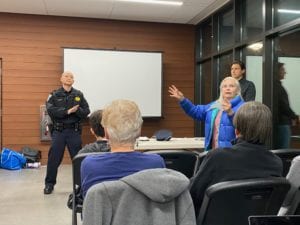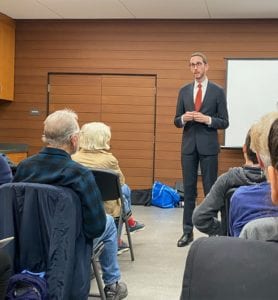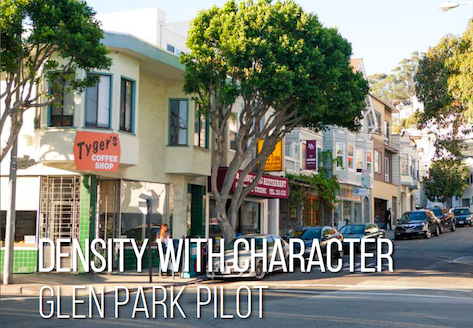Photos by Michael Waldstein

The quarterly meeting had a great turnout – folks were anxious to hear from several local leaders who came to give updates and hear about neighborhood concerns.
First up–
Introducing Ingleside Captain Christopher Woon:
Captain Chris Woon made his first appearance since assuming his position at the Ingleside Station. Born and raised in the Ingleside, he gave a brief rundown of his extensive and varied law enforcement positions over the last 25 years, including: airport bureau patrol; officer at Northern, Ingleside and Taraval districts; dog handler for explosives (“best partner in the world”); sergeant at the Mission and Southern Stations with the investigations and risk management units.
The top priorities of SFPD are the protection of human life, increased public safety, and outreach to the community. It’s a big challenge to use limited resources strategically to combat crime.
There were a few questions about staffing.
Woon said each captain must apportion resources according to the needs of the district. Ingleside is one of the largest, and officers are spread out all over. In the event of a serious crime, officers from other districts provide backup to each other.
An Ingleside officer is assigned to do traffic enforcement. The downtown motorcycle unit will come out to provide support to troubled areas, such as the Elk and Chenery intersection. Plainclothes officers use the crosswalk to catch violations.
The captain gave some statistics.
The top increases in need for police over the past couple of years are homelessness and quality of life issues, living in cars, living on the sidewalk and need for medical assistance. These take up a lot of resources. Also, violent crime – domestic violence, assaults, burglaries and robberies. However, burglaries are down 30% and robberies are down 13%.
What can we do to deter crime? Neighbors can form a neighborhood watch, facilitated by SF SAFE. They will also do free home security assessments. Have a phone tree with your neighbors. Be aware of your surroundings. Don’t leave items visible in your car. Get a dog!
Most important, report ALL crimes so the police can allocate their resources where needed. Any crime in progress or having just happened should be a 911 report. If it’s a “cold crime,” call police at the non-urgent number, 553-0123.
Legislative update by State Senator Scott Wiener:

The senator was pleased to be back in Glen Park. He was elected to the state senate at the same time President Trump was elected and he noted that the state has since had to relitigate the nonstop assault on our basic values. “With all the chaos, we also have problems we have created, and we have to fix.”
Issues in the legislature—
Homelessness is always a real challenge, exacerbated by the housing crisis, meth, opioids, and mental health issues. We’re now seeing major encampments outside the cities: in the suburbs, the coastal areas and inland. California has 25% of the nation’s homeless.
Wiener was able to pass legislation to streamline approval of navigation centers. He also passed legislation to create a pilot program of conservatorship for persons with intractable issues of mental health and addiction. “We need to acknowledge that allowing people to fall apart and die on the streets isn’t progressive or compassionate. This legislation will save lives,” he said.
He’s introduced legislation to require insurance companies to approve all mental health and addiction care, not only in crisis. Along with that, he wants to expand access to young people in high school and college. He noted, “Once someone has a break, it’s harder to help them.”
Wiener favors state authorization for safe injection sites to deter crime, infection, and syringe litter. He realizes this is an uphill climb with the current administration in Washington.
Governor Newsom is more forthcoming on allocating funding – over $1 billion – to help cities and counties ramp up emergency shelters, mental health services, eviction support and access to MediCal.
SB50 (just defeated in the state senate -ed.) would have addressed the shortfall of 3.5 million houses that’s been building up over many years. It would have superseded local zoning laws, to increase housing density near transit- and job-rich hubs.
Having more people in a neighborhood, rather than decreasing quality of life, Wiener contends, would add more vitality by increasing foot traffic and supporting local businesses.
The housing crisis has made people struggle, forced them to move elsewhere, and decreased diversity across the board.
In response to a question about how transit would be impacted by SB50, Wiener said a lot more investment would be needed in new property and transfer taxes. In the works now are bonds that will provide expanded BART service, more MUNI, light rail and Cal Train over time.
After three or four years of intransigence, there’s been a victory in finally getting the Cow Palace to cease holding gun shows. It’s a temporary ban and there will be legislation to make the ban permanent.
 Density with Character: Glen Park pilot
Density with Character: Glen Park pilot
Supervisor Mandelman said that, although he doesn’t support SB50, he feels obligated to find a solution to help alleviate the housing crisis in San Francisco. Through his office, he and legislative aide Jacob Bintliff (formerly of the Planning Department) have come up with a proposal that aims to be a local alternative to SB50.
Remodels and newly built homes in Glen Park often top 6,000 square feet. Mandelman’s proposed legislation seeks to densify those square feet so they accommodate more than one family.
The program would be launched in Glen Park as a testing ground. Some of the elements include:
- Applies to new construction or remodeling
- Moves away from RH-1 zoning (single family housing) prevalent in Glen Park
- Provides incentives to add additional units per lot
The core concept in the pilot plan is a cap on Floor Area Ratio (FAR), the ratio of home to lot size. For example, if the average FAR in Glen Park were a guide (0.6), a 1,500-square-foot home would be allowed on a a 2,500 square foot lot. For two units, the building could be no bigger than 1.2 FAR.
Another feature addresses minimum and maximum unit size, so that units in the same building are not out of proportion with each other, e.g., one very large unit and one very small unit.
Glen Park height limits are currently low – mostly 40 feet in residential areas and 35 feet in the commercial corridor. The pilot program does not include height changes. Existing code requirements such as setbacks and open space will be maintained so as to conserve neighborhood character.
This was the initial presentation of the pilot program proposal to the community. There will be more to come, and people will have the opportunity to weigh in with their vision for Glen Park. The next step will be for the City Attorney to draft an ordinance establishing the program, followed by environmental review. Ultimately, the plan will need to be approved by the full Board of Supervisors.
To see the full slide presentation, click here: https://www.glenparkassociation.org/gpa-jan-23-mtg-final/
GPA Officer Election:
The annual election of officers is mandated in the bylaws of the Glen Park Association. This year there was one change in the candidate slate.
President: Scott Stawicki
Vice president: Hilary Schiraldi (formerly of the safety committee, replacing vice president Stephany Wilkes)
Treasurer: Dennis Mullen
Recording secretary: Heather World
Communications secretary: Bonnee Waldstein
Membership secretary: Adrienne Lacau
The slate was elected by voice vote of the members in attendance.
Updates from the Glen Park Association:
GPA president Scott Stawicki gave a rundown of some transit issues in Glen Park.
Diamond/Bosworth intersection: The improvements made thus far (traffic light patterns, lane adjustment, sidewalk bulb outs, etc.) were actually Phase One. Phase Two was supposed to address the Arlington/Bosworth intersection. SFMTA presented several concept plans, none of which were an improvement and, in fact, were worse in some respects. That part of the plan is now dormant.
There is a lot of concern and frustration about the unsafe pedestrian crosswalk at the I-280 South on-ramp. The GPA is pushing for some improvement, but SFMTA tends to take a “comprehensive” approach to problem solving, which causes solutions, even seemingly simple ones, to get stalled for a very long time.
Private buses loading at the BART station block sight lines for vehicles attempting to enter the I-280 South on-ramp. SFMTA has no jurisdiction over this. By California state code, it’s CalTrans’ responsibility because the bus zone is adjacent to a highway. Google and Genentech voluntarily pay to use the bus zone; UCSF chooses not to pay.
SFMTA seems to be more willing to do traffic calming on residential streets. Pending now is the installation of two or three speed humps on Chenery Street around Lippard Street. To get traffic calming on one’s street, fifty percent of the residents need to sign a petition to the SFMTA. SFMTA will then do a traffic study to determine what, if any, measures are required. Stop signs are not part of the traffic calming program.
Elk/Sussex Street crosswalk: This project was supposed to be completed but it hasn’t been started. We now hear a design drawing should be done this month (January) and construction in late spring. It will feature a pedestrian activated flashing beacon at both sides of the intersection. All parking on the Glen Canyon Park side of the street will be removed for safety considerations.